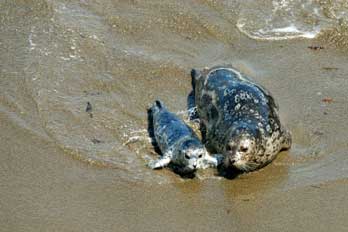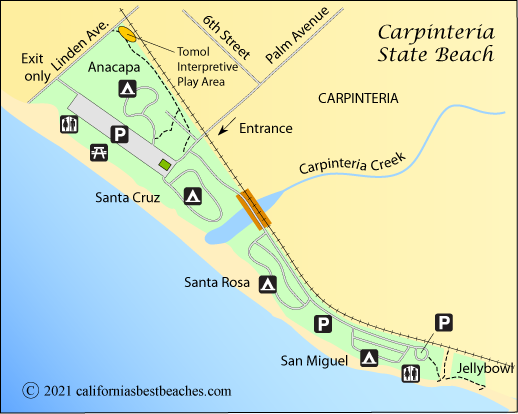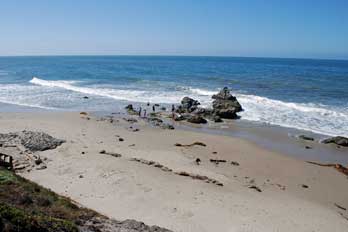Carpinteria State Beach
Carpinteria Beach is popular with families and swimmers because the gentle slope of the ocean floor makes it one of the safest beaches on the California coast. Visitors enjoy sunbathing, exploring the coast line and tide pools, camping, and surfing.
Located at the site of an early Chumash Indian village, Carpinteria State Beach has woven the Native American history into the fabric of the state beach with interpretive programs, information signs, the Tomol Interpretive Play Area, and the visitor center exhibits. The tar found along the beach was used by the Chumash to seal their canoes. The villagers living at the mouth of Carpinteria Creek were admired for their skill at building canoes.
Wildlife at Carpinteria State Beach
Observant visitors to Carpinteria State Beach will find wildlife in several different habitats. Carpinteria Creek and its tidal lagoon are home to a variety of birds and small animals. Among the birds you may spot there are marsh wrens, great blue herons, and ducks. Out along the beach watch for shore birds, from gulls to California brown pelicans. The Carpinteria Salt Marsh Reserve, a short distance to the northwest, offers even more great opportunities for birding. Access is limited, however, so check their website for information.
The tide pools are home to a myriad of sea creatures, including sea stars, anemones, crabs, snails, chitons, octopi, sea urchins, and periwinkles.

Harbor Seal Preserve
By following hiking along the Coastal Vista Trail to the east, visitors reach the Harbor Seal Preserve. It is located beyond the Chevron Oil Pier. The beach is closed during the birthing season from December 1 through May 31, but seals can be seen basking in the sun there year-round from nearby observation points. Bring binoculars for a close up view.
You will likely encounter a member of Seal Watch, volunteers who keep watch on the seals to protect them from any intrusion that might disturb them. The harbor seal colony is protected by law. Care should be taken not to disturb them in any manner, including making loud noises or approaching past the warning signs.
Tomol Interpretive Play Area
In the northwest corner of Carpinteria State Beach is the Tomol Interpretive Play Area. The play area features a replica Chumash Village where children can climb, play, and explore while at the same time learning about life in an early Chumash community. Among the items in the play area are Chumash huts, Rainbow Bridge, and life-size animal statues.
The play area was the result of years of work by the Rotary Club of Carpinteria Morning, the City of Carpinteria, California State Parks, and the local community.

Carpinteria City Beach
At the foot of Ash Avenue is Carpinteria City Beach, 500 yards of ocean front with a safe swimming beach, lifeguards, and restrooms. The beach connects with Carpinteria State Beach. Behind the city beach, north of Ash Avenue, spreads the Carpinteria Bluffs Public Open Space. It contains 53 acres of natural preserve with trails and great views of the ocean.
Tar Pit Park
Tar Pits Park is located southeast of Carpinteria State Beach, before the oil company pier. There are no facilities at the 8-acre park except a few benches and hiking trails. Signs of the underground asphalt lakes are evident as the tars leak up through fissures in the earth. The area was once an open asphalt mine.


